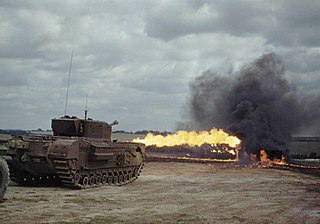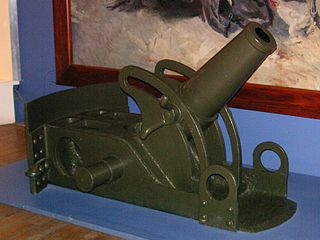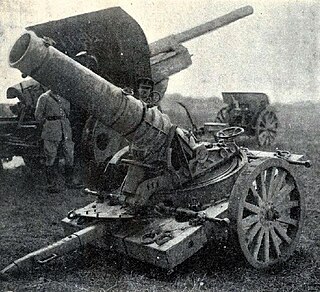Related Research Articles

A flamethrower is a ranged incendiary device designed to project a controllable jet of fire. First deployed by the Byzantine Empire in the 7th century AD, flamethrowers saw use in modern times during World War I, and more widely in World War II as a tactical weapon against fortifications.

A jerrycan is a robust liquid container made from pressed steel. It was designed in Germany in the 1930s for military use to hold 20 litres of fuel, and saw widespread use by both Germany and the Allies during the Second World War.

A flame tank is a type of tank equipped with a flamethrower, most commonly used to supplement combined arms attacks against fortifications, confined spaces, or other obstacles. The type only reached significant use in the Second World War, during which the United States, Soviet Union, Germany, Italy, Japan, and the United Kingdom all produced flamethrower-equipped tanks.

The Flamethrower, Portable, No 2, also known as the Ack Pack, was a British design of flamethrower for infantry use in the Second World War.

The Flammenwerfer 35, or FmW 35 was a one-man German flamethrower used during World War II to clear out trenches and buildings. It could project fuel up to 25 meters from the user.

The Lagonda company produced a number of flamethrowers during the Second World War.

The Abwehrflammenwerfer42 was a German static defensive flamethrower, flame fougasse or flame mine used during the Second World War. The design was copied from Russian FOG-1 mines that were encountered in 1941 during Operation Barbarossa. These were usually buried at intervals of 11 to 27 metres covering road blocks, landing beaches, harbour walls and other obstacles. They were normally mixed in with other mines or emplaced behind barbed wire and could be command detonated or triggered by tripwires or other devices.

The Churchill Crocodile was a British flame-throwing tank of late Second World War. It was a variant of the Tank, Infantry, Mk IV (A22) Churchill Mark VII, although the Churchill Mark IV was initially chosen to be the base vehicle.

The first German man-portable flamethrower was called the Kleinflammenwerfer or Kleif. Fuel was stored in a large vertical, cylindrical backpack container. High-pressure propellant was stored in another, smaller container attached to the fuel tank. A long hose connected the fuel tank to a lance tube with an igniting device at the nozzle. The propellant forced the fuel through the hose and out of the nozzle at high speed when a valve was opened. The igniting device at the nozzle set fire to the fuel as it sprayed out. The flamethrower was operated by two soldiers, one carrying the fuel and propellant tanks, another wielding the lance. Wex, a replacement for the Kleif, was introduced in 1917 after the third battle of Ypres.

The Wechselapparat (Wex) was a World War I German flamethrower introduced in 1916 to replace the earlier Kleif. Developed by Richard Fiedler, as early as 1901. It had a doughnut-shaped backpack fuel container with a spherical propellant container (nitrogen) in the middle that blasted the gasoline. The containers were made of welded car rims, which made it easier to carry it yourself. A corrugated rubber hose led from the tank at the ends of which there were valves that enables mixture of fuel and propellant dispensing under pressure to the metal fuel pipe which had handles on both sides. Wex used a magnesium ignition system in a nozzle. In order for the fire to burn longer, tar was added to the gasoline or instead of it fuel oil was completely used up. It was used throughout the war, and some survived flamethrowers have been used by the Finns in the 1920s and then converted to Flammenwerfer 40. This design was updated before the Second World War to become flamethrower model 35. However, model 35 was considered too fragile so it was soon replaced by the model 41, a simpler construction with smaller, horizontal, cylindrical backpack containers.

The Mortier de 58 mm type 2 or Mortier de 58 mm T N°2, also known as the Crapouillot or "little toad" from its appearance, was the standard French medium trench mortar of World War I.

The Flammenwerfer M.16. literally meaning it "throws flames" in German was a German man-portable backpack flamethrower that was used in World War I in trench warfare by the Germans. It was the first flamethrower ever used in combat, in 1916 at Verdun by the Germans. It was also used in 1918 in the battle of Argonne Forest in France against Allied forces by Germans, as featured in the 2001 film The Lost Battalion where the main character fights German, although an account in a 1917 issue of The Living Age suggests eye witness accounts of it being used at the Battle of the Somme in 1916 by Germans.

The M1 and M1A1 were portable flamethrowers developed by the United States during World War II. The M1 weighed 72 lb, had a range of 15 meters, and had a fuel tank capacity of five gallons. The improved M1A1 weighed less, at 65 lb, had a much longer range of 45 meters, had the same fuel tank capacity, and fired thickened fuel (napalm).

Albrecht mortars or Albrecht Schwerer Minenwerfers were a series of wooden heavy mortars used by the Imperial German Army during the First World War.

The 10.5 cm Gebirgshaubitze L/12 was a mountain howitzer used by Germany, Bulgaria, and the Ottoman Empire during World War I.

The 24 cm schwere Flügelminenwerfer IKO or 24 cm sFIMW IKO was a heavy mortar used by the Imperial German Army during the First World War.

The Mortier de 58 T N°1 sometimes referred to as Lance Torpilles was an early French medium trench mortar of World War I. Built in small numbers it was a transitional type in the development of later French mortars.

The 24 cm schwere FlügelMinenWerfer Albrecht, or 24 cm sFIMW 17 Albrecht, was a heavy mortar used by the Imperial German Army during the First World War.

The Mortier de tranchee de circonstance Cellerier or Cellerier Mortar was an early French light infantry mortar of World War I. The name roughly translates to (Cellerier Improvised Trench Mortar) in English.

The Mortier de 58 T N°1 bis sometimes referred to as Lance Torpilles was an early French medium trench mortar. It was used by both the French Army and Italian Army during the First World War.
References
This article includes a list of references, related reading, or external links, but its sources remain unclear because it lacks inline citations .(November 2014) |
- Flamethrowers of the German Army 1914-1945 by Fred Koch
- http://firstworldwar.com/weaponry/flamethrowers.htm